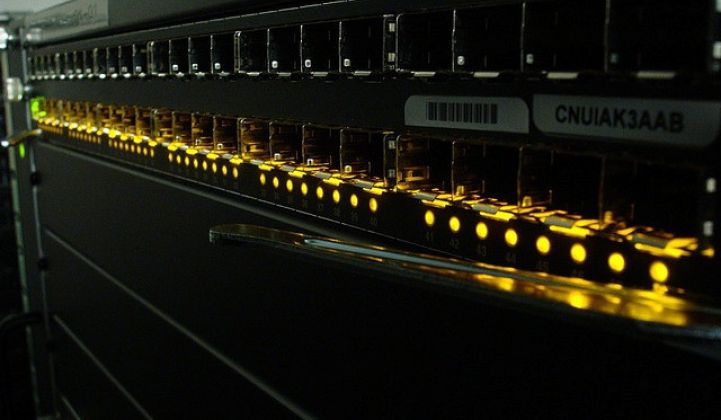Ever since it got into the smart grid business three years ago, Cisco has been promising to network every part of the grid. Since then, we’ve seen it deliver on some pieces of that vision, like substation routers and smart meter networks, and back away from others, like building energy management.
On Tuesday, the networking giant unveiled its most wide-ranging set of new “Connected Grid” products and services yet, complete with a new network management system to run multiple smart grid systems, as well as its “GridBlocks Architecture” (PDF) reference model to help utilities put the pieces together.
The goal is a "single, intelligent and highly secure platform" that should lower total cost of ownership and create functional integration of all the networks -- smart meters, distribution automation, demand response, transmission and generation -- that make up a modern utility. Cisco is deploying various pieces of the platform for customers including Australia's AusGrid, Canada's BC Hydro and the world’s biggest utility, State Grid Corp. of China.
Cisco is holding a webcast on the announcement this morning, and we'll be updating you with details. The company has been promising capabilities like this for a long time, so the surprises will no doubt be in just how customers are putting this interoperability to use. Here's what's on the table:
- Cisco’s long-promised field-area network (FAN) solution aims to bridge the gaps between its substation routers and switches being used by big customers like Duke and FPL, and the smart meter networking it’s doing with partner Itron. The FAN comes with a new grid router device, the 1000 series Connected Grid router, as well as the promise of linking up with endpoint devices like smart meters, distribution automation systems and grid monitors and controls. A big question is how Cisco integrates with the smart meter networks already in place from the likes of Silver Spring, Trilliant, SmartSynch, and the big meter makers.
UPDATE: Besides BC Hydro, Cisco named San Diego Gas & Electric as a pilot customer for its FAN system. Its new Connected Grid Router 1240 supports 2G/3G cellular modules, 900-megahertz wireless mesh, WiMAX modules and promises 4G capability on the wireless side, and also has embedded interfaces for Ethernet, serial, Wi-Fi and GPS.
- On the substation and transmission side, Cisco is adding moduler communications capabilities to its 2000 series grid routers -- devices that have competition from the likes of Ambient and SmartSynch -- as well as support for next-generation synchrophasor deployments like the one it's doing with the Western Electricity Coordinating Council. It's also touting a full security suite that will, among other things, seek to integrate the SCADA networks that will soon be subjected to inclusion to a list of networks all North American utilities must protect, or pay millions of dollars in fines.
UPDATE: Duke Energy, Ausgrid and First Wind are using Cisco's system to manage SCADA communications, and supports protocols like DNP-3, MODBUS, and IEC 60870-104 by tunneling them over an IP network between substations and control centers. Cisco is promising full use of all the heightened security measures available to IPv6 networks, but at some point it will have to connect to legacy devices that lack the computing power to run IP, which requires security measures that go beyond its traditional expertise.
- Cisco is also promoting a host of services to help utilities line up smart grid network platform capabilities with their business plans, which sounds like a packaging of its “gridonomics” research work as a service. It’s also announcing a new “Connected Grid Visualization and Design” tool that’s been Cisco's entree into China's smart grid market.
- Cisco also makes some interesting claims for its Connected Grid Network Management System, to wit, "end-to-end monitoring and control of the network communications, delivering enterprise-class visibility that can currently scale to manage up to 10 million endpoints." We're going to see an explosion of "network of networks" smart grid offerings in 2012, with big new entrants like Cisco and, most recently, SK Telecom with its GridMaven business. The idea is to bring telecom-level reliability and monitoring capability to the dozens of vendor-specific networks that now run as individual fiefdoms within utilities -- but moving from monitoring to control will take some time.
UPDATE: BC Hydro will be Cisco's first NMS customer, rolling it out to manage a Cisco-Itron FAN/smart meter system meant to connect 1.9 million meters and thousands of other grid "endpoints" by the end of 2012.
Just how many pieces of Cisco’s new smart grid offerings will be taken up by the industry remains to be seen. Most of Cisco's smart grid work today centers on transmission and substation networking. BC Hydro is the first publicly named utility using both Cisco’s smart meter and field-area networking capability, though the two partners say more are in the works.
Of course, Cisco’s influence in the smart grid extends beyond its named utility projects (or deployments that may be going on under the radar). Cisco has built a long list of partners in the industry, including such high-profile players as General Electric, SAIC, CapGemini, Oracle, OSIsoft, Siemens, Schneider Electric and Verizon, as well as startups including Space-Time Insight, Proximetry, Pulse Energy and many others. It bought wireless networking startup Arch Rock in 2010 and has been applying that technology, built to comply with upcoming IPv6 protocols, in its Itron partnershp.



